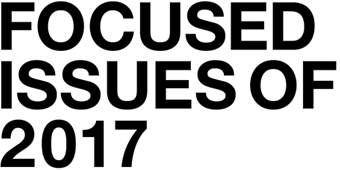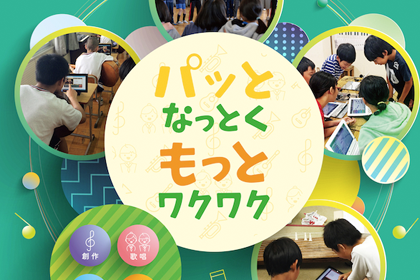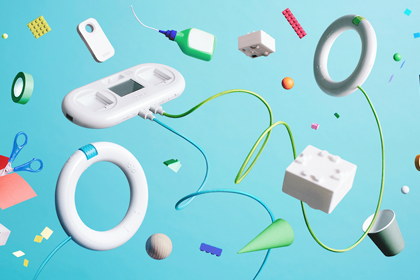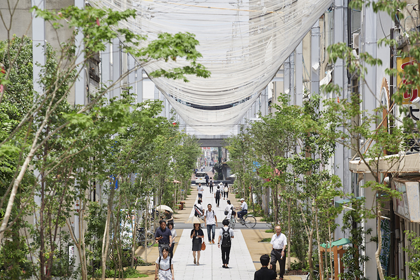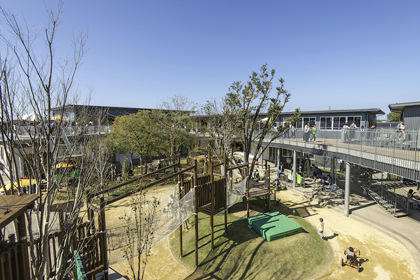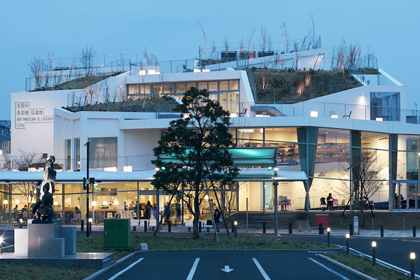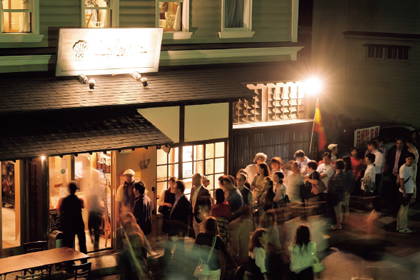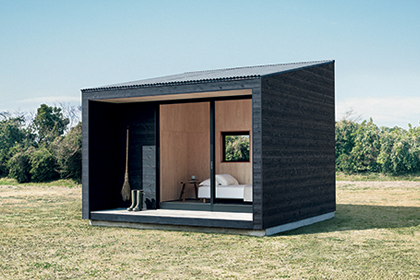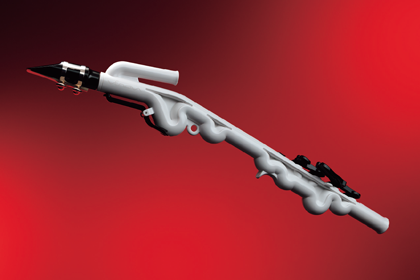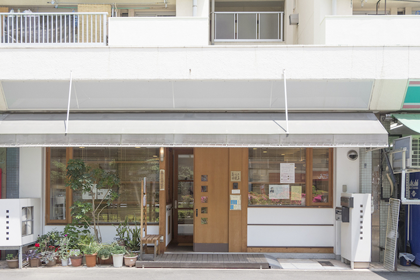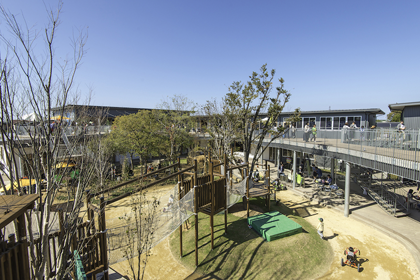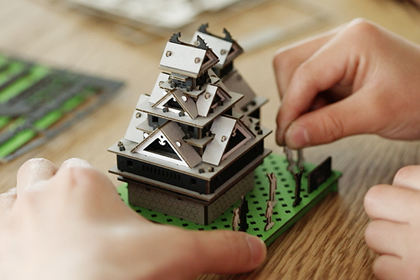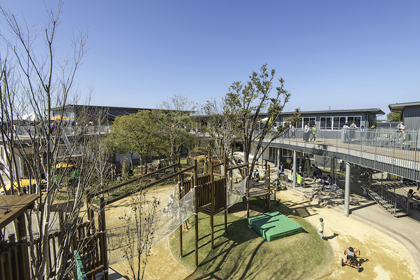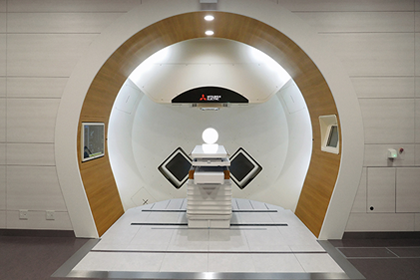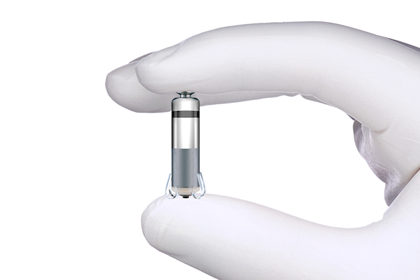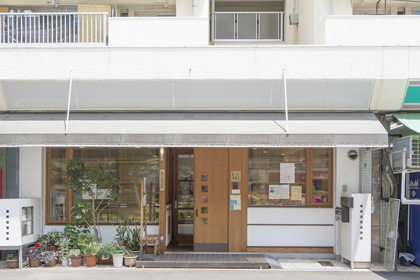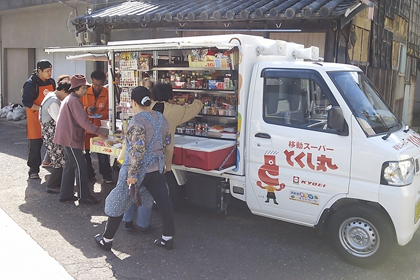
The potential social impact of design, as seen through the lens of the Good Design Award program, is something we explore in FOCUSED ISSUES. Much design in the diverse award winners each year responds to current and anticipated social issues. We identify key themes relevant to issues such as these, which are addressed by our Focused Issue directors in essays that endorse promising responses among the new award winners and discuss their significance.
All eight FOCUSED ISSUES this time are carefully phrased, following a certain pattern. Each mentions a common social concern and a desirable outcome. Here, we are suggesting the desirable outcomes that seem necessary for these issues, and suggesting that good design may help us get there.
We can imagine quite a range of approaches to these social issues. Some approaches do not reflect the viewpoints and methods of careful design, of course, but the kind of good design recognized by the program is especially effective in solving problems. Surely good design promises solutions that are truly desirable and charts a path that gives us hope. A regard for humanity lies at the heart of sound design, and it is from this perspective that we explore FOCUSED ISSUES to bring to light what good design is currently focused on and what it may be capable of in the future.

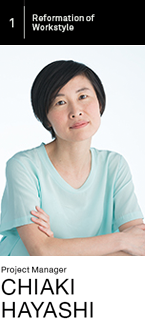
Co-Founder, Loftwork, Inc. She is heads Loftwork, a creative agency, which rolls out 200 projects annually. The agency operates multiple services: "loftwork.com", an online network of over 22,000 creators, "FabCafe", a digital manufacturing cafe, and "MTRL", a creative space for creators.
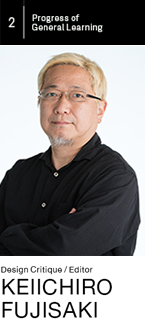
Professor, Tokyo University of the Arts. After working as the chief editor for the "Designers' Workshop" magazine, he got involved in writing articles, and editing magazines and books regarding design as a freelancer.

CEO, Jiyujin inc. In 2000, the first magazine "JIYUJIN" was published. He moved his office to Minami Uonuma (Niigata) from Tokyo. His lifestyle is focused on by the mass media. In 2004, He created a new style of hotel named SATOYAMA JUJO in Niigata.

Associate Professor, Waseda University. As a board member of NPO Commonsphere, he has been promoting the idea and system of "Creative Commons" in Japan since 2004. As an entrepreneur, he co-founded Dividual Inc, to develop human-centric web services and smartphone apps.
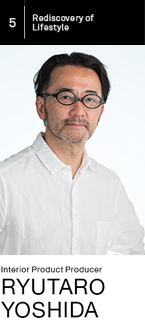
Managing Director, PRESTIGE JAPAN Inc. Manages Time & Style, an interior furnishings company, stores, and factories.
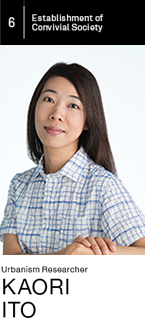
Professor, The Tokyo University of Science. Her areas of specialization are urban space analysis and design. Her research interest includes the relationships between public space and public life. She leads the artist group Tokyo Picnic Club and is involved in creative projects for urban public space.

Division Manager, National Museum of Emerging Science and Innobation. She started her career as a new media art curator and was appointed to Miraikan in 2002. After an year professional internship at MoMA, sent from Japanese Agency for Cultural Affairs, she moved back as a chief.

Professor, The University of Tokyo. Through specific themes such as designing a line of products, discovery of the trade-off points, and management of changes in customer requests, he is trying to develop new system design and management methods in the SoS era.



Who benefits from new work styles, and where these changes lead
Reforming the way we work may not initially seem very compelling. In the first place, it is not clear what should be accomplished through this reform. Do we want to reduce overtime? Or are we seeking freer working styles? The aims should be clear before we can even begin to discuss it.
Also undermining this enterprise is that these two objectives seem contradictory. Although moves to reduce overtime may seem limited in scope, they represent tighter control over the workplace. In contrast, those seeking freer working styles want to relax uniform controls or rules. These people—and here, it may be helpful to imagine startup workers or those in creative jobs—seem to be saying that they will decide their own working style, so please leave them alone. Tighter control over working hours is utterly outdated, according to them. If the objectives are viewed as being contradictory, like a kite flying this way and that, they seem to undermine the intent of reform by promoting unstable conditions.
But interestingly, viewed from the perspective of Hannah Arendt, these two aims are actually aligned, and both point in the same direction. One book by this German-born philosopher, The Human Condition, divides human activities into labor, work, and action. In her words, we might say that work today is in the process of changing from labor to work, and finally, to action. We take action not because we are forced to, or simply because it is useful. We take action as unique individuals among a plurality of others. Both in limiting working hours to improve labor and in somehow capitalizing on each person's abilities in diverse work, we see a respect for individuals, who are unlike any other individual. In both efforts, working is essentially viewed as our reason for being. From this conceptual basis, both goals seek the same future.
Trends toward divergent work styles, driven by technology
Surveying this year's award winners for examples of this trend toward different ways of working, we are reminded that many people today consider how they work to be a facet of their overall lifestyle. And as ways of working become increasingly diverse, surely these changes are enabled by technology. Some may fear that technology will steal jobs, but in fact, it takes over the jobs nobody wants, or the jobs people do not excel at. This ends up giving people a chance to do work that interests them and spend their time in more satisfying ways.
Meeting expectations in this regard is Send, a food distribution platform that links producers and consumers. This platform overcomes limitations such as inefficiency in current distribution between these parties, leveraging an enormous amount of data analysis to link those who produce and those who order fresh food and vegetables. As an advanced distribution system maintaining information on areas, times, and attributes of the agricultural and livestock products consumed, Send can match those who produce and consume specialty foods outside the scope of conventional distribution. In this way, the system supports diverse lifestyles among the discerning producers.
Even at larger corporations, some are questioning the routine of workers reporting to the same place at the same time to do their allotted tasks. In Mitsui Fudosan's Working Style Project, employees of contracted corporate clients can work at any of the real estate developer's shared offices across Japan, where IT helps prevent information leaks and keeps track of hours worked. This gives companies some options in their employees' working styles and locations.
Softbank's Short Working Hours Program is significant for promising a fuller role in society for those who may not easily fit within the regular framework of employment, such as disabled individuals. Here, work is analyzed from ergonomic perspectives and broken down to identify tasks that can be readily assigned to those with physical or mental disabilities who can only work for shorter periods. By taking a fresh look at the tasks that make up various work, companies can remain competitive while creating opportunities for those who would otherwise have limited employment prospects.
Free spirits, each one a hero
Still, broad social reform in the ways we work is currently in a period of transition. Arendt also reminds us that unlike the modern meaning of the word "hero," which applies only to exceptional people, this word once applied to all free men who became Trojan warriors. Heroes were once those who spoke and took action for themselves, and this self-determination marked the start of their own story. If so, surely we will need the kind of design in society that encourages this autonomous action by unique individuals and takes full advantage of it.
A human asset that technology will never replace is initiative. This ceaseless impulse has shaped the world we live in today, enabling seemingly impossible things that our ancestors would never have imagined. For each new way of working that emerges, the story of another hero begins.



Does current education in Japan nurture creativity? We find creativity in all the distinguished figures who appear in Apple's 1997 Think Different ad campaign: Pablo Picasso, Albert Einstein, John Lennon, Martin Luther King, Jr., Mahatma Gandhi, and others. They drew from a deep well of inspiration and expressed themselves with keen determination. Still, misunderstanding creativity as something only extraordinary people have threatens to put it out of reach of ordinary people.
Before we can nurture the kind of creativity behind innovation and solutions to social issues, we should ask ourselves what creativity is all about. By no means is creativity limited to the ability to express ourselves well. We should not equate creativity with drawing or writing well, for example. Nor should we equate creativity with originality or eccentricity. Instead, I see four aspects of creativity: artistic expression, hypothesizing(abduction), problem-solving, and empathy/self-reference.
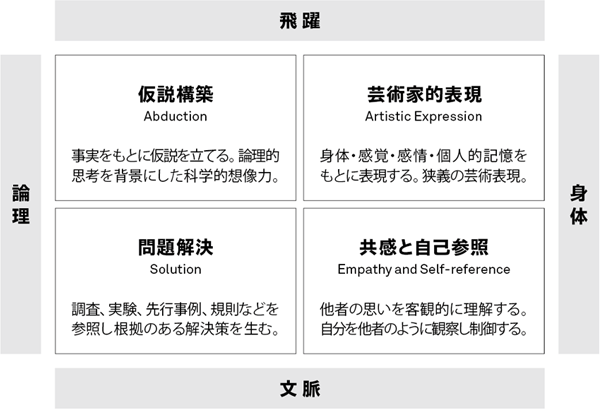

Four fields of creativity
Artistic expression is a physical kind of creativity. More specifically, it is a form of expression rooted in the body, senses, emotions, and personal memory. This is artistic creativity in the narrow sense, generally attributed to artists.
Hypothesizing involves establishing tentative theories by finding hidden relationships or unknown truth based on objective reality. It relates to what the American philosopher Charles Sanders Peirce called "abduction," different from deduction or induction. As a good example of this, imagine Newton hypothesizing about universal gravitation between objects after seeing an apple fall from a tree. Many outstanding scientists have applied this ability to pioneer scientific advances.
Problem-solving is creativity that yields sound solutions, based on an analysis of fieldwork or experiments and grounded in precedent, principles, and data. We might describe the ability to derive solutions by finding and tapping external resources as an ability to look beyond oneself. Unlike hypothesizing, which requires an abductive leap, problem-solving involves inductive reasoning. By collecting objective data and analyzing it according to established principles, anyone can arrive at similar answers. These answers vary, however, depending on what data you examine and how you examine it, so expert problem-solving depends on data-gathering skills, experience, refinement, and contributors' abilities.
Empathy and self-reference enable us to see ourselves in others, and vice versa. Through observation and objective analysis, both perspectives help us imagine what we or another person would think under the circumstances, which gives us some self-control and affects our behavior. As abilities not used solely for self-expression, they are essential to designers, who create tangible and intangible things used by others. They are also indispensable to actors, and to those who work in welfare or service industries. Normally, however, empathy and self-reference are not considered aspects of creativity. In the original sense, creation involves creating something from nothing. Although we could not describe settings such as cancer hospices as "creating" anything this way, few would deny that it takes creativity to work so closely with terminally ill patients, dealing with matters of life and death each day.
True creativity balances the four aspects of artistic expression, hypothesizing, problem-solving, and empathy/self-reference well. Accordingly, it can inspire design that transcends simple problem-solving. To distinguish design from art, people often insist that design solves problems, rather than being a form of artistic expression, but good design requires all four of these aspects of creativity. In particular, to me, the work of expert designers reflects their empathy, self-reference, and regard for physical sensations.
Products that nurture creativity
On the topic of creative learning, two Best 100 award winners this year were intriguing: Yamaha's Vocaloid for education and Primo Toys' Cubetto.
The first is Vocaloid-enhanced educational software that invites young students to make music and lyrics such as a class song together. Quite admirably, the product serves as a collaborative creative platform, drawing on shared emotions, rather than focusing on individual self-expression. Cubetto toys for younger children encourage cognitive development. By matching shapes—an early lesson in computer programming—children move a block-like wooden robot along a course. Here, a physical experience builds logical thinking, and playing with the toy also stimulates children's imagination through spatial recognition. Early gains in both kinesthetic awareness and logical thinking must be a first step toward nurturing true creativity. Toio from Sony also encourages cognitive development and teaches about programming. Future development of this DIY toy kit is interesting to imagine.
Children are not the only ones who need creativity, however. When we think of arrangements that also encourage adults to express their latent creativity, we realize that this area is still largely undeveloped. A few brilliant artists and scientists should not have a monopoly on creativity. Through good design, there must be unlimited possibilities to help cultivate creativity in everyone. Good design may depend on empathy and self-reference, but it also balances the other three aspects of creativity well, as a form of interdisciplinary knowledge that links many fields and shapes future lifestyles.



Design "trends"
Until recently, trends were orchestrated by designers, marketers, magazine editors, TV directors, ad agency chiefs, and others. What will be the next hot topic? What are the trendsetters contriving to do? Anticipating such matters proved lucrative to them.
Times have changed. We are flooded with information, from social media and elsewhere, which has given us the freedom to choose for ourselves what is trending. As a result, we now see the will of the people on a smaller scale.
Sometimes this small-scale consensus is exclusive, and at other times, it is controversial. It brings us together and tears us apart, rocking the world. On the other hand, it has expanded our perspective. We can now appreciate that opinions on beauty, usability, or other qualities may vary widely.
Small-scale consensus and a middle ground
In this environment, it has become quite hard to orchestrate trends that are universally appealing. Paradoxically, it is harder to find silver-bullet solutions that resonate nationwide.
When considering the matter of cultivating local communities, we can distill the concept of locality down to things that set an area apart. It is deceptively difficult to cultivate or extend this distinctiveness, which consists in the small-scale consensus of local groups, is intertwined with local economic interests, and is in a constant state of flux.
Surveying examples of design in the award program from this perspective, we can discern a few key concepts. One is a middle ground, whether between beauty and diversity, business and volunteering, public and private, and so on. This middle ground brings together aspects of what we want and what actually exists in the everyday world. Specifically, a significant theme is how well design work integrates and reflects the will of the people on a small scale.
However, this middle ground does not involve compromise (as accepted by many in Japan) or splitting the difference. Instead, there is a process of new creation, which is the focus of creative work.
Respecting memory
Another key concept, when this middle ground is addressed in creative work, is respecting memory.
One Gold Award this year was given to the renovation of an outdoor shopping arcade in Fukuyama, Hiroshima. Here, we admired how the planners intentionally kept the original pillars in the new arcade, preserving a memory. In this way, the project stands in the middle ground between past and present, between beauty and diversity. Despite this intermediate stance, the work is not moderate—it is quite distinctive.
An award-winning community center in Hakusan, Ishikawa, shows insight on local and social matters, and the new balance it strikes sets a good example for other communities. Here, a cluster of buildings serves various purposes including senior day care, disabled nursing care, and nursery school care, but those without disabilities also visit for the hot spring, restaurant, and other facilities. This jumble of roles brings together people of all kinds. On reflection, we realize that this kind of mingling used to be common, both in extended families and rural villages. Thus, we see how respect for memory has inspired something new.
We can also observe how respect for a diverse city has inspired new creation in Ota, Gunma, in the form of a museum and library . In urban development, we can take the view that planned scenery should itself be beautiful, or we can believe that the greater the mix of new and old, the more organic a place will be. Not only is this site visually striking outside, walking around inside convinces us that the uniform convenience we once thought convenient actually discouraged new discoveries and experiences and obstructs reconciliation and understanding.
Superficial descriptions
On this note, many people are still under the misconception that design is all about how concepts are expressed visually or in tangible output. Of course, it is true that one aspect of design is seeking formal qualities that appeal to our senses, as seen in graphic design or product design. But if we look only for superficial trends, we misjudge more substantive developments.
For example, some design work may fall under the category of renovation. Many renovation projects have been awarded in recent years, such as a Gold Award-winning suburban apartment complex in Kanagawa in 2016. But it would be too shallow to think that the era of renovation is over simply because no projects among the Best 100 happened to be described this way.
Problem-solving processes
I prefer to consider design as a problem-solving process. The three award winners mentioned clearly all attempt to solve or alleviate social issues, and they can be described in similar ways. From this perspective, there are clear reasons to commend other highly original award winners that are more conceptual (as in process-making) than physical, such as a culinary event in Hakodate or a drop-in center addressing the everyday concerns of seniors .
The depth of human resourcefulness
As the Tokyo Olympics draws near and inbound tourism continues to surge, big cities in Japan are so economically dynamic that we tend to overlook chronic social issues there. But the fact remains that problems are piling up in suburbs, rural cities, and farming villages.
Problem-solving from a human perspective
Advances in AI will herald an era where we can look for a middle road with greater accuracy, and more easily find a satisfying sense of direction. Still, solutions requiring creativity and innovation remain beyond the reach of AI, which also lacks a human respect for memory.
Outstanding design and creative work relies on human resourcefulness, and all of us can appreciate the depth of this work. In this way, the epitome of design thinking is problem-solving with human creativity.



In the program this year, the focused issue under my direction was "Development of Social Infrastructure." We must be especially careful about the word "development." In Japanese, this word also refers to evolution in natural history, but what we mean is the result of random adaptation to random environmental changes, not purposive at all. Given the nature of selective pressure in the market, attempting to gain a comprehensive understanding of industry and design inevitably devolves into the nihilism of "whatever happens, happens." Thus, as the result of natural evolutionary history ourselves, we must be careful about the variable of our "intentionality" when discussing social development. In other words, beyond future predictions accounting for the big-picture view of how society will develop, we must also discuss design-related hopes based on a clear determination of how we wish to develop society.
Today, we can see this kind of discussion beginning to emerge, here and there. We have seen more opportunities around the world to reconsider the social infrastructure of nuclear power since the Tohoku disaster and Fukushima nuclear accident, and interest in renewable energy has grown. So, too, has the ever-worsening problem of exploitative companies stimulated discussion on new ways of working, and as an alternative to the longstanding money-making drive of capitalism, people are also taking a fresh look at social entrepreneurship and NPOs. We are seeing gradual changes in conventional notions of companies and work. In the field of IT as well, Facebook changed their thinking on an attention economy that had gone too far. In January the company announced that they would reduce highly toxic advertising and content and switch to a newsfeed algorithm that emphasizes user well-being.
These cases show that people can change the direction taken in social development through a kind of social genetic engineering. In biology, epigenetics deals with the inheritance of characteristics acquired by the previous generation. Because the stance that the acquired traits of individuals can be inherited violates a central dogma associated with Darwinism, it has long been discounted, but biotechnological advances in recent years have rekindled interest. We might say that on every level of society, from micro to macro, we are building up the methodologies of a design-driven epigenetics that questions past conventions and charts a course to a better future. The issue is whether this will be valuable in ways that make us proud to be human.
Several products among entries from Japan and China (specifically, Hong Kong) that I reviewed seem to respond to these issues. Personally, I was most impressed by an entry in the Hong Kong screenings: a facial recognition system that uses crowd-sourced information about lost children to help parents find them. At a time when people continue to rave about machine learning in profit-driven applications, this system demonstrates how a nonprofit uses advanced technology to address the social issue of missing or abducted children. I hope to see more along these lines in the future. Another entry awarded in Hong Kong was an ultrasonic fetal camera for home use. Instead of needing to go to a clinic, people can appreciate the new life inside expectant mothers from the comfort of home, where husbands who might otherwise feel like outsiders during pregnancy can participate more actively as a parent. Some have pointed out that the device might support sex-selective abortions in China, where a one-child policy was long observed. However, technological enhancements can help prevent this. It is also valuable in Japan, where paternal engagement is generally so inadequate that a new word had to be coined for active fathers.
Amazon Dash buttons, or specifically, their underlying AWS IoT Button technology, is commendable for introducing a means for the masses to design their own programmable HEMS. In food, clothing, and shelter, customizability has been limited to luxury goods and the finer things, but bringing IoT to Amazon Web Services may offer an IT-linked democratization of everyday basics. Muji Hut and the Snow Peak mobile home scale down the concept of ownership, which, along with parallel advances in autonomous vehicles, may transform how people tied to a certain plot of land view housing. A project in Taiwan turns unused areas into parks, showing a new way to encourage the optimization and active public use of these shared land resources. Data visualization efforts by The Nikkei newspaper set a good example in data-driven journalism for gaining a clearer view of social conditions through data and evidence, although I fear that unless others follow this example, current "filter bubble" conditions will not change. As for how we interact with music, Yamaha has taken both computerized and physical approaches in a music education program applying Vocaloid technology and an appealing new wind instrument. Both are wonderful efforts that support development in the sphere of music.
Looking back on this year's entries from the perspective of developing social infrastructure, I was reminded that despite several admirable achievements, too few projects seemed to respond directly to an awareness of these issues. It would be reassuring to expect more projects to introduce the kind of epigenetics that takes society, with its flashes of hope and despair, forward from the level of infrastructure.



Contemporary lifestyles
We can interpret a "lifestyle" as being the lived experience that contributes to a contented life—the sum of all the satisfying moments we have, and a measure of our quality of life. Recent years have seen our everyday lives greatly transformed by the Internet, as the ways we live continue to be shaped by technological advances. People of all ages now seem to own some kind of computing device. Communicating through these devices has become second nature, and if we have something to say, we reach for a device to share our thoughts. Even children can access sites of all kinds, and they both study and play in the digital world. It is also hard to restrict this access and protect children from the bottomless pits online, where predators lurk. Meanwhile, through a process of natural selection, one digital innovation gives way to the next, whether a cryptocurrency or some new social infrastructure, evolving at a faster pace and spreading into our lives. These are the facts of life, in contemporary lifestyles. Seemingly inevitable, trends toward tomorrow's digital society will accelerate, and in Japan, where the population is declining and labor shortages can be offset by AI, robots, and similar innovation, it will be a key challenge to build a society where people coexist with these things.
However, we face serious social issues in this digital society, such as a lack of humanity or the loss of real human ties in our families or communities. Finding solutions—the legacy we leave for our children—is our profound responsibility.
Uniquely Japanese lifestyles
Japan has its own distinctive lifestyles. Although lifestyles and traditional cultures of all kinds here have evolved through rapid natural selection since the Meiji Restoration and exposure to Western ways, our lives and communities still retain much culture that is uniquely Japanese, even today. One example is the inner life of people in Japan, which is still rooted in Japanese culture, but there are others. Long-enduring lifestyles, arts, and crafts are still alive and well, and in the future, Japanese culture may provide insight to people around the world on ideal forms of lifestyles and communities. Japanese culture itself is not exclusively made in Japan. Cultural heritage has been handed down from China, Korea, and elsewhere over the course of 2,000 years, with a cultural infusion from the West in medieval times. In this way, indigenous and foreign cultures have blended together as our distinctive culture took shape. This uniquely Japanese culture will become globally appealing as a lifestyle that enriches social life, including the world's social life in general. In most of the countries that have passed down culture to Japan in the past, the original cultural heritage has been lost and no longer exists. But Japan will return the culture that the world has passed down to it, and this act of transmission will build positive ties around the world.
Community life
We can also interpret a "lifestyle" as referring to the richness of humanity in everyday life. Historically, society has grown as ties between individuals led to families, and then communities. Especially in disaster-prone Japan, these communal ties encouraged neighbors to help each other, and communities grew to influence the business of everyday life. Communities developed and passed down their own ways, and the communal ties fostered from their crafts and traditional cultures made life fulfilling and created new value. Larger areas then served as a community, where people of all ages lived together. In this context, one Good Design Special Award winner provides community advice on a myriad of everyday issues. Here, on a shop-lined street, on the first floor of a large residential complex with many seniors, anyone can drop in for free assistance on matters of health, medical treatment, home care, and everyday life. The initiative anticipates needs in a graying society by helping seniors who live alone to feel comfortable and part of their community. In response to these social issues in everyday life today, such projects with human warmth hold the potential to redefine communities as reassuring places where solitary seniors can enjoy neighborly ties. In this, we recognize an attempt to restore a sense of community that Japan has lost.
Also meeting local needs in many ways is an award-winning community center in Hakusan, Ishikawa. Here, elderly and disabled residents receive nursing and medical care, while children are cared for at a nursery school. People of all ages and abilities mingle at the hot spring, restaurant, fitness center, and elsewhere, showing how community ties that have weakened in Japan can be restored. Programs such as these represent admirable new design focused on fundamentals of community life in years to come, and they provide an answer to current social issues faced across Japan.
Bringing the lifestyles of Japan to the world
Much that is made in Japan is made by hand, to an extent rare in the industrialized world. This reservoir of manual expertise by those with a knack for subtlety and detail has supported the precision of domestic production. Found everywhere across the country, traditional manual industry has a long history. In fact, the craftsmanship behind most of this venerable, diverse, and exquisite production now exists only in Japan. Bringing these sensibilities to manufacturing processes can create products that are alive with human spirit, and bringing a craftsman's touch to the finish can yield industrial products with textures unmatched by machines alone. Design and finish that capitalize on the subtlety of Japanese sensibility can endow products with fine textures, revealing value only possible with Japanese craftsmanship. As we rediscover satisfying lifestyles, we can rediscover many early qualities passed down as a unique cultural heritage over the course of Japan's long history. By taking a fresh look at our uniquely Japanese culture, we find new things to appreciate. I look forward to the creation of future-minded lifestyles with new technologies and historical perspective in balance.



On this broad topic, we will restrict the scope of this essay to social harmony. To explore how effective design can help toward this end, we can classify notable winners this year into three approaches they take.
Bridging gaps between outsiders and current social systems
Assuming that society consists of majorities and minorities, there will always be some individuals who are excluded from social systems, which are generally designed for the majority. One way to bridge this gap is with inclusive design.
Among the winners in this year's program, we noticed work that bridges the gap between social systems and those who are disadvantaged in some way, whether by ability, age, nationality, access to shopping, or other factors. These entries took many forms. Some are award-winning products, such as Panasonic Let's Remo-con AD/ST TV remote controls for those who have upper limb disabilities or are receiving high-level care. Others are services, such as the Mieru-Denwa speech-to-text service that displays on a smartphone what other parties say during calls. Still others are programs, such as an employment arrangement with shorter working hours for those with mental or developmental disabilities. Regardless of their category, all were much more than an elegant product or fitting project. They showed good design across a series of processes, from how problems were identified to how solutions were provided.
Learning about others
From the perspective of the majority, these gaps are easy to overlook. But if they are leaving minorities to fend for themselves, we will have a longer road to social harmony. Instead, the kind of inclusive design cited above alters majority perceptions and helps build this society.
Labeling others as somehow unsettling or pitiable imposes a distance between us. This denies the possibility of smooth social relations. With life in a slightly clearer focus, however, we can often appreciate diversity and develop a regard for others' welfare. One may wonder why visiting designers at Feemue, a lifestyle brand based in the Thai slum of Klong Toey, spend time in such a troubled place, but they are drawn to the charms of this environment, where their bags and fashion accessories are made by locals. Once in the hands of buyers, the products are admired as "cool" or "beautiful," overturning preconceptions about unsettling or pitiable conditions. This design brings us a step closer to social harmony.
Similarly, disaster zones should not merely arouse sympathy but should also be recognized as places that once held their own charm. Beyond sympathizing with those affected, we can find fun, stylishness, and culinary pleasures in several disaster recovery projects, such as Kumamoto Castle papercraft kits, bags made of used blue emergency tarp, or the morning market on the rebuilt Yuriage wharf. This design refrains from singling out disaster areas for pity and instead encourages social harmony.
Normalizing social harmony with others
In reality, there are no firm boundaries between majorities and minorities. We may easily find ourselves on either side. Everyone is different, after all. Before praising the ties between us, then, we should recognize the simple fact of social diversity and accept that many others differ from us in ability or preferences. Although some cities or regions have historically shown tolerance by welcoming a diverse mix of people, applying good design to express this inherent disposition seems to be difficult. The difficulty may arise because design often serves a single role well, to the exclusion of others.
However, one award winner this year shows the potential of a pluralistic approach. This community center serves a "jumble" of roles and people, in the words of the architects. It welcomes people regardless of age, ability, or state of health. Loosely clustered around a courtyard, various buildings provide adult day care for seniors, nursing care for those who are disabled, education at a nursery school, medical care, and more. Visitors can have a meal, soak in a hot spring, exercise at a gym, and even browse at a flower shop. The center as a whole also provides employment opportunities for people with disabilities. Just as public spaces have traditionally brought people together, the social welfare corporation that manages the center is demonstrating what social harmony looks like.
In our lives, we may find it hard to relate to some things, and this may become stressful. The more convenient life seems to become, as innovative technology or systems enter everyday life, the more we may try to avoid stress and surround ourselves with our preferred things or information. Social media shows only articles or photos that resonate with us. Recommended books or news are easy to relate to, and events bring together only like-minded people. In time, we may see a world where no one is different from us. And then, as our imagination fades, it will be a desolate world indeed. Establishing social harmony is essential not for the sake of specific people but because it is where social prosperity must lie.
This constructive work will falter with the kind of design that serves only the short-sighted convenience of individuals. The community center is just one hopeful example of design that brings people great pleasure, but now that we seem intent on dismantling social harmony, it is time to appreciate what this constructive design can do.



Defining advanced technology
No one would doubt that advanced technology is new, freshly invented technology. However, a few points should be clarified, such as what is new about it, how new is it, and from whose per-spective is it new. Examples of advanced technology that excited people in 2017 are AI and VR, in the fields of information and imaging, respectively. Other hot technology-robots, autonomous vehicles, drones, fintech, and so on-seems to be on the verge of wide-scale deployment and poised to overturn manufacturing, transportation, distribution, finance, and other basic industries.
But is it truly advanced technology? In fact, it is not. After each technology was invented decades ago at universities or research institutes, prototypes were created, and at last, they have become common. VR is a perfect example. The basic idea and prototypes existed as early as the 1960s.
As for where the truly advanced technology is, it is used and tested at universities, institutes, and other special settings in the long-term pursuit of fundamental scientific truths and R&D, inacces-sible to all but a select few. This kind of advanced technology is the focus of this essay.
Technology behind the walls of academia and research labs
The 2013 Good Design Award program I participated in was a veritable festival of advanced tech-nology. Award winners included Hayabusa, the ALMA telescopes, and SACLA, which the program celebrated not only as world-class observation facilities and systems enabling significant future research but also for the underlying manufacturing expertise and the organizations' public rela-tions. Still, very few people actually operate these systems. Some observers must have thought it odd to evaluate their "interface" design.
Today, remarkable scientific advances are occurring in many fields. Constant discoveries and inven-tions in various fields make us question basic human assumptions. People are pioneering undiscov-ered frontiers in space and deep in our own planet. In biology, we are closing in on mysteries or evolutionary changes in nature and life. In energy and new materials, we are pushing boundaries in resources and matter. And in information, we are expanding conceptions of time and space. Quite broadly, the technologies behind this research make the invisible visible, control the infinitesimal, defy time, space, and the laws of physics, or manage vast amounts of information, among other things. Every year, the pace of remarkable advances in these technologies and related inventions accelerates, as it grows to scales normally unfathomable or simply unimaginable to us. Yet there are still few instances of public interfaces that give people access to it.
An era when advanced technology involves us, and human interfaces
In applications of advanced technology, good design brings the knowledge and technology in these research fields, which is on scales that far surpass what people can deal with, down to a human scale. A role of design is to provide an interface between advanced technology and people, giving rise to new users and industries. In this sense, the award-winning design in this year's program con-tinues to serve as an interface, to some extent, between those of us alive today and advanced technology.
Examples of applied technology that makes the invisible visible include a super-resolution fluores-cence microscope, the MELTHEA compact particle therapy system, and the Veraview X800 dental 3D x-ray system, all in the field of medicine. Each also ad-dresses the prohibitive size, cost, or expertise usually required, which makes the equipment availa-ble to a wider user base and helps popularize the technology. As applied technology that defies our notions of time or space or that manages vast amounts of information, we can cite the Theta V 360° camera, the Synapse 3D image analysis system, and an 8K VR amusement ride. The first captures panoramas of the world around us, the second makes visible the complex internal structures of the body, and the third immerses us in VR through movement and high-resolution images. An intriguing example of applied technology that controls something very small can be found in the PaperLab A-8000 waterless in-office paper recycling sys-tem. And last, a candidate for this year's Grand Award, the Micra Transcatheter Pac-ing System is a tour de force of technical and manufacturing expertise.
As history unfolds, along with our inventions and innovations, we continue to flourish through en-lightenment and culture or wreak destruction in wars. Culture emerged long ago with language and farming, and energy brought the light of day into the night and gave us power. Now, IT is changing human awareness and abilities—even for core concepts long taken for granted, such as human beings and the planet. The act of linking advanced technology to human beings is tantamount to the act of creating humans of the future. The body and the environment were long viewed as being bound by natural laws, but an era where they can be controlled artificially and where human be-ings themselves are a frontier of design is an era where our ties with advanced technology will run deep. Without a doubt, it is precisely in times such as these that design fulfills a tremendous role and bears a great responsibility in creating human interfaces, and we find a need for new perspec-tives on technology and design.



System design
As society grows more diverse and complex, what sense of security can we hope to find? Society itself is a kind of system, made up of people. When considering design that makes us feel secure, it is therefore useful to take the academic or research perspective of systems engineering.
Systems, whether physical or conceptual, consist of various elements or factors that are interconnected. This interconnectedness makes systems valuable and useful to us. One important way social systems benefit the people in them is by providing a sense of security.
To foster security in society, social systems must be designed appropriately. Specifically, the elements needed for a reassuring social system and the connections between them must be well designed.
Building a sense of security through trust
Security is often discussed with safety. Safety is a physiological need associated with survival. It is an objective concept with a scientific basis. In contrast, security is a subjective concept associated with our attempts to guarantee that we feel safe. The factors that give us this peace of mind usually vary from person to person.
If people find it hard to feel comfortable with a particular social system, they try to ensure a sense of security by looking for other people or organizations that are at least a little more reassuring. From this process of relieving our anxiety to feel more secure, we can appreciate the vital role played by trust. Earning social trust is an effective way to ease anxiety in society and establish reasonable social support.
Linking elements, building a sense of security
One approach to rectifying worrisome systems is to consider how to create elements that inspire confidence and link them to other elements (specifically, to elements that do not).
However, because reassurance varies from person to person, trying to create elements that relieve a variety of anxieties is challenging and may end up making systems more complex.
Forms of systems that help avoid complexity include arrangements that are self-organizing, or distributed and cooperative. Along these lines, what is essential in inspiring the confidence that underlies security is to consider connections, and how to arrange certain connections.
Relieving anxiety through new elements: Dropping in for advice
One stressed population at present consists of seniors with weaker ties to dependable family members. This has become a serious social issue. A winning entry this year epitomizes how system elements can be created to relieve this anxiety—by inviting members of a predominantly senior housing complex to stop by anytime for advice. Importantly, the enterprise engages with and effectively offsets a factor of anxiety (specifically, living alone). The clever positioning as a neighborhood drop-in center, rather than a clinic, makes it more inviting. This encourages residents to visit, talk a little, and ease their concerns about health and welfare. Also significant is that the center is designed to help patrons build ties with a mix of others who stop by.
Relieving anxiety by fostering relationships: A patient-pharmacist app
Instead of alleviating anxiety by introducing new elements like this, some approaches foster new relationships through existing elements. A good example of how interpersonal ties are formed today is SNS. The social networking aspects of an award-winning app called Sukoyaku-talk are expertly employed to encourage chatting between patients and pharmacists. By opening a channel of communication for informal advice from pharmacists on matters of health and medicine at any time, the service helps eliminate patient anxiety.
As this service becomes more popular, it promises to keep people healthier and reduce hospital visits, which also addresses the significant social issue of controlling medical expenses. In this way, the design of this service not only relieves immediate health and medical anxieties but is also linked to assuaging our concerns about the future state of the nation.
As long as users develop the requisite relationships of trust, the system as a whole will work as intended. In response to a complex issue involving many elements, this is a breath of fresh air in connective design from a systems perspective.
Solving multiple stressful issues at once: Grocery trucks
One problem that has emerged in some of Japan's graying, dwindling communities is a lack of access to shopping. Goods are generally abundant elsewhere, but the lack of local shopping has become a serious concern. In response, one award-winning solution brings together those who are suffering for different reasons, whether from the basic matter of shopping, from business uncertainties, or other reasons.
This business arrangement links each party, reassuring consumers who are worried about shopping, local grocers concerned about business risks, and stressed would-be employees or entrepreneurs whose prospects are limited. Admirably designed, it responds to potential needs, neatly ties the elements together, and balances the responsibilities and benefits of each element. It is quite socially relevant, because it relieves anxiety in society, but it is also a promising business model. By establishing a win-win relationship among several parties, it creates a sense of security.
From relieving anxiety to creating value: "Send" distribution platform
Commerce under changing conditions carries a range of risks and troubling uncertainties. In the food service industry, producers may worry about demand, and restaurateurs about supply. One way to offset the gaps between placing and receiving orders and facilitate a stable supply of small lots, which both cause stress for buyers and sellers, is a service called "Send," which links discerning producers and restaurant owners.
We can feel especially secure after introducing advanced technology tapping current forms of sophisticated IT. This accurate data analysis and redeveloped distribution system represents a shift from merely relieving anxiety to creating value.
Design that connects and reassures
We live in times that present immediate anxieties and future concerns. Ideally, we should eliminate both.
As conditions become even more complex, the interconnectedness of a variety of things should inspire trust and reassure us. These connections can lie between people, or between people and physical or conceptual things. What is most important is to consider the kind of arrangement that will make the connections. This is central in designing a sense of security.
Fostering this security involves a mechanism within systems that relieves anxiety by changing things for the better, through apparently subtle connections. These are exactly the kind of arrangements-the kind of design-that society will need in the future.
→ 2017 FOCUSED ISSUES and message
→ 2016 FOCUSED ISSUES and message
→ 2015 FOCUSED ISSUES and message


